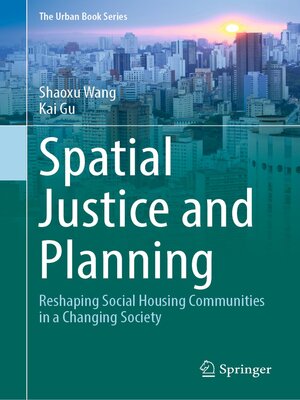Spatial Justice and Planning
ebook ∣ Reshaping Social Housing Communities in a Changing Society · Urban Book
By Shaoxu Wang

Sign up to save your library
With an OverDrive account, you can save your favorite libraries for at-a-glance information about availability. Find out more about OverDrive accounts.
Find this title in Libby, the library reading app by OverDrive.



Search for a digital library with this title
Title found at these libraries:
| Library Name | Distance |
|---|---|
| Loading... |
Despite the significance of urban justice in planning research and practice, how just societies and cities can be organised and achieved remains contested. Spatial justice provides an integrative and unifying theory concerning place, policies, people and their interplay, but ambiguities about its practical bases have undermined its application in planning. Through creating and substantiating a new conceptual framework comprising a morphological study, policy analysis and embodiment research, this book crystallises the spatiality of (in)justice and (in)justice of spatiality in the context of social housing redevelopment.
Like many countries around the world, social housing in Aotearoa New Zealand is an area of contention, especially at the building and redevelopment stages. Protecting community character and human rights has been used by social housing tenants to resist changes, but the primary focus on material outcomes neglects broadening access toplanning processes. Compact, mixed tenure and sustainable (re)developments are regarded as the just built environment, as they enable equal accessibility to all. But there are contradictions between the planned spatiality of justice and individuals' socialised sensory space. Reconciliation of morphological differentiations in built forms and social cohesion remains a challenging task.
This book focuses on the re-examination, integration and transferability of spatial justice. It makes a new contribution to urban justice theory by strengthening spatial justice and planning. Social housing areas are expected to adapt to changing social and economic demands while retaining much-valued established community character. This book also provides practical strategies for tackling complex planning problems in social housing redevelopment.
Like many countries around the world, social housing in Aotearoa New Zealand is an area of contention, especially at the building and redevelopment stages. Protecting community character and human rights has been used by social housing tenants to resist changes, but the primary focus on material outcomes neglects broadening access toplanning processes. Compact, mixed tenure and sustainable (re)developments are regarded as the just built environment, as they enable equal accessibility to all. But there are contradictions between the planned spatiality of justice and individuals' socialised sensory space. Reconciliation of morphological differentiations in built forms and social cohesion remains a challenging task.
This book focuses on the re-examination, integration and transferability of spatial justice. It makes a new contribution to urban justice theory by strengthening spatial justice and planning. Social housing areas are expected to adapt to changing social and economic demands while retaining much-valued established community character. This book also provides practical strategies for tackling complex planning problems in social housing redevelopment.







